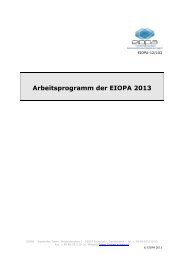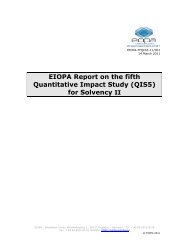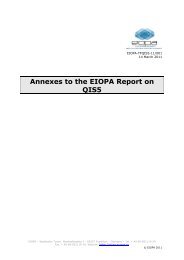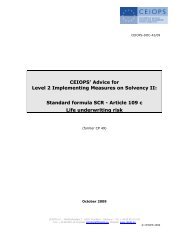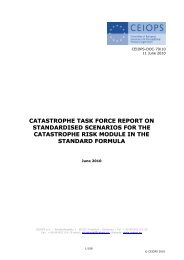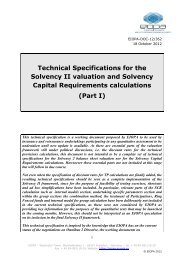CEIOPS Task Force Report on the Liquidity Premium - Eiopa
CEIOPS Task Force Report on the Liquidity Premium - Eiopa
CEIOPS Task Force Report on the Liquidity Premium - Eiopa
Create successful ePaper yourself
Turn your PDF publications into a flip-book with our unique Google optimized e-Paper software.
#7. No liquidity premium should be applied to liabilities in <strong>the</strong> absence of a<br />
corresp<strong>on</strong>ding liquidity premium evidenced in <strong>the</strong> valuati<strong>on</strong> of assets.<br />
#8. The design and calibrati<strong>on</strong> of <strong>the</strong> SCR standard formula should ensure<br />
that its calculati<strong>on</strong> is c<strong>on</strong>sistent with a recogniti<strong>on</strong> of a liquidity premium in<br />
<strong>the</strong> valuati<strong>on</strong> of liabilities and compatible with <strong>the</strong> set Solvency II target<br />
criteria for solvency assessment. The calculati<strong>on</strong> of <strong>the</strong> SCR with internal<br />
models should also include an appropriate recogniti<strong>on</strong> of <strong>the</strong> risk arising from<br />
<strong>the</strong> liquidity premium in order to guarantee <strong>the</strong> targeted c<strong>on</strong>fidence level.<br />
#9. The undertaking should have in place risk management systems and<br />
investment policy provisi<strong>on</strong>s specifically oriented to <strong>the</strong> risks inherent to <strong>the</strong><br />
applicati<strong>on</strong> of a liquidity premium, including liquidity risks.<br />
I - 5. Methods of calculati<strong>on</strong> of a liquidity premium for assets<br />
Three main methods currently used by practiti<strong>on</strong>ers to estimate <strong>the</strong> liquidity premium<br />
in financial markets have been presented by industry.<br />
− <strong>the</strong> CDS Negative-Basis Method which compares <strong>the</strong> spread <strong>on</strong> a corporate b<strong>on</strong>d<br />
with <strong>the</strong> spread of a Credit Default Swap for <strong>the</strong> same issuing entity, same<br />
maturity, same seniority and same currency.<br />
− <strong>the</strong> Covered B<strong>on</strong>d Method which involves choosing a pair of assets which, besides<br />
liquidity, are assumed to offer equivalent cash flows and equivalent credit risk. The<br />
primary example is an index of covered b<strong>on</strong>ds versus swaps.<br />
− <strong>the</strong> Structural Model Method which involves <strong>the</strong> use of opti<strong>on</strong> pricing techniques<br />
to calculate a <strong>the</strong>oretical credit spread which compensates <strong>on</strong>ly for credit (default<br />
and spread) risk. The difference between <strong>the</strong> <strong>the</strong>oretical spread and <strong>the</strong> actual<br />
market spread is typically taken to be liquidity premium.<br />
The following graph gives <strong>the</strong> values of <strong>the</strong> liquidity premium calculated for <strong>the</strong> period<br />
from <strong>the</strong> last quarter 2005 to <strong>the</strong> third quarter 2009 for <strong>the</strong> euro. It should be noted<br />
that this chart shows liquidity premium relative to swaps. The proxy method also<br />
included in <strong>the</strong> graph is based <strong>on</strong> a liquidity premium calculated with a simple formula<br />
described in annex A. Similar graphs for o<strong>the</strong>r currencies are also provided in <strong>the</strong><br />
same annex.<br />
Financial literature recognizes drawbacks for each of <strong>the</strong>se methods.<br />
12/33<br />
© <str<strong>on</strong>g>CEIOPS</str<strong>on</strong>g> 2010



